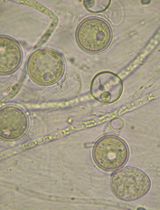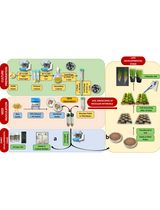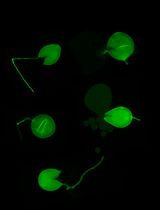- EN - English
- CN - 中文
Bacteria-fungal Confrontation and Fungal Growth Prevention Assay
细菌 - 真菌对抗和真菌生长预防试验
发布: 2018年01月20日第8卷第2期 DOI: 10.21769/BioProtoc.2694 浏览次数: 9136
评审: Alessandro DidonnaPushpendra SinghMichael Tscherner

相关实验方案

微生物提取物对卵菌辣椒疫霉菌和猝倒病疫霉的体外筛选
Mónica Trigal Martínez [...] María Ángeles Vinuesa Navarro
2025年09月20日 401 阅读
Abstract
There are some bacteria which can grow and multiply at the cost of living fungal biomass. They can potentially utilize fungi as a source of nutrients to forage over them. Such phenomenon is known as bacterial mycophagy, however, its mechanistic insights need to be explored to identify the molecules involved in mycophagy for potential utilization in controlling various fungal diseases. Recently we have demonstrated that a rice-associated bacteria Burkholderia gladioli strain NGJ1 exhibits mycophagous ability on several fungi, including Rhizoctonia solani, the necrotrophic fungal pathogen causing sheath blight disease in rice. We hereby describe our validated and efficient methods used to study B. gladioli strain NGJ1-R. solani interactions. These methodologies would be useful for designing assays to study the confrontation between bacteria and fungi which in turn enable discovery of novel antifungal molecules from such bacteria.
Keywords: Burkholderia gladioli (唐菖蒲伯克霍尔德菌)Background
Rhizoctonia solani is an important plant pathogenic fungi with a wide range of hosts. It causes sheath blight disease in rice; the second most devastating fungal disease of rice after Blast disease (Fisher et al., 2012; Ghosh et al., 2014; Ghosh et al., 2017). In wake of developing control methods of sheath blight disease of rice, we isolated a bacterium with a broad spectrum antifungal activity from rice seedling. Based upon the rDNA and draft genome sequencing, the bacterium had been identified as Burkholderia gladioli strain NGJ1 (Jha et al., 2015). Beside antifungal property, we observed that the NGJ1 has the ability to forage over fungi and exhibit mycophagous ability on R. solani as well as various other tested fungi. Upon interaction with R. solani mycelia, NGJ1 growth was drastically enhanced. The NGJ1 imparted cell death response in R. solani and caused disintegration of fungal mycelia. We further established that the bacteria utilize type III secretion system to deliver a prophage tail-like protein (Bg_9562) to feed on R. solani (Swain et al., 2017).
Materials and Reagents
- 1.5 ml and 2.0 ml microcentrifuge tubes (Tarson, catalog numbers: 500010 and 500020 )
- Pipette tips (10 μl) (Tarson, catalog number: 521000 )
- Pipette tips (200 μl) (Tarson, catalog number: 521010 )
- Pipette tips (1,000 μl) (Tarson, catalog number: 521020 )
- 15 ml culture tubes (Riviera, catalog number: 71200155 )
- 30 ml culture tubes (Riviera, catalog number: 71200305 )
- Microscopic glass slides (GEM, catalog number: 051 )
- Toothpicks
- Petri dishes (90 mm) (Tarson, catalog number: 460090 )
- Rhizoctonia solani AG1-IA strain (Lab collection)
- Burkholderia gladioli strain NGJ1 (Lab collection)
- Milli-Q water
- Ethanol (Merck)
- Potato dextrose agar (PDA) (HiMedia Laboratories, catalog number: GM096-500G )
- Potato dextrose broth (PDB) (HiMedia Laboratories, catalog number: GM403-500G )
- Sodium nitrate (NaNO3) (Fisher Scientific)
- Dipotassium phosphate (HiMedia Laboratories, catalog number: MB044-500G )
- Magnesium sulfate heptahydrate (MgSO4·7H2O) (HiMedia Laboratories, catalog number: GRM684 )
- Potassium chloride (KCl) (HiMedia Laboratories, catalog number: MB043 )
- Ferrous sulfate heptahydrate (FeSO4·7H2O) (HiMedia Laboratories, catalog number: GRM1377 )
- Dimethyl sulfoxide (MP Biomedicals, catalog number: 02196055 )
- Czapek dox broth (CDB) (HiMedia Laboratories, catalog number: M076-500G )
- Czapek dox agar (CDA) (HiMedia Laboratories)
- (Optional) KBA (HiMedia Laboratories, catalog number: M1544-500G )
- Potato Dextrose Agar (PDA) (see Recipes)
- Potato Dextrose Broth (PDB) (see Recipes)
- Czapek dox agar (CDA) (see Recipes)
- Czapek dox Broth (CDB) (see Recipes)
Equipment
- Forceps
- Stainless steel forceps (HiMedia Laboratories, catalog number: LA710 )
- Pipettes (Eppendorf-that can accommodate pipette tips of 10 μl, 200 μl, 1,000 μl)
- Milli-Q water purification system (Merck, model: Milli-Q® Advantage A10,catalog number: Z00Q0V0WW )
- Autoclave (INDFOS-110-PB)
- Incubator and shaker (28 °C) (mrc, catalog number: LOM-65 )
- Microcentrifuge (TOMY DIGITAL BIOLOGY, model: MX-301 )
- Laminar Air Flow (Azbil Telstar, model: Telstar Bio II Advance, catalog number: EN 12469 )
- Light microscope (Nikon, model: Eclipse E100 )
Procedure
文章信息
版权信息
© 2018 The Authors; exclusive licensee Bio-protocol LLC.
如何引用
Kumar, R., SWAIN, D. M., YADAV, S. K., Tyagi, I., Kumar, R., Das, J., Ghosh, S. and Jha, G. (2018). Bacteria-fungal Confrontation and Fungal Growth Prevention Assay. Bio-protocol 8(2): e2694. DOI: 10.21769/BioProtoc.2694.
分类
微生物学 > 微生物-宿主相互作用 > 细菌
植物科学 > 植物免疫 > 宿主-细菌相互作用
您对这篇实验方法有问题吗?
在此处发布您的问题,我们将邀请本文作者来回答。同时,我们会将您的问题发布到Bio-protocol Exchange,以便寻求社区成员的帮助。
提问指南
+ 问题描述
写下详细的问题描述,包括所有有助于他人回答您问题的信息(例如实验过程、条件和相关图像等)。
Share
Bluesky
X
Copy link














